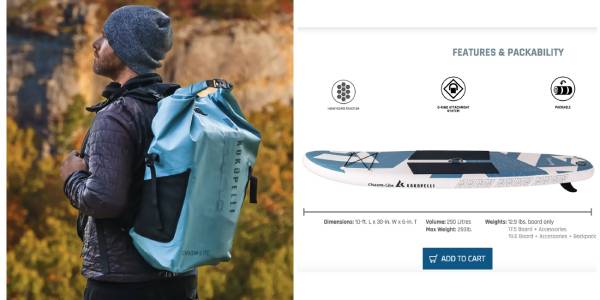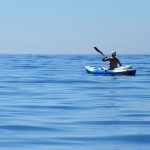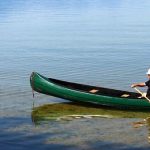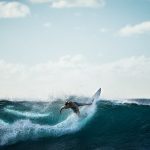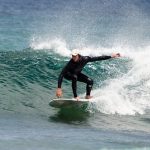You’ve probably seen someone walk on a tightrope while holding a long pole in front of them, extending horizontally out to either side. This helps provide balance.
If you’ve walked a slack line or even just walked along a curb without falling, you’ve instinctively put your arms out wide to either side to assist with balance.
Having something attached to the center of your body that extends out to either side allows you to more easily make the fine adjustments necessary to maintain balance.
The distance the pole or your arms extend from your body allows extremely small adjustments and counter-adjustments to be effective.
Now imagine balancing on a tightrope with your arms at your sides. The adjustments you make are a) much more likely to be appropriate and b) much less likely to be excessive, resulting in more accurate balance.
It’s easier to balance on a tightrope with your arms by your side than it is to balance on a slack line or the curb. The adjustments you make are more likely to be appropriate and less likely to be excessive when balancing on a tightrope, resulting in more accurate balance.
Imagine you are standing on a SUP Board. The SUP Board is moving because the water is a fluid. The SUP Board’s movement is also affected by its shape and width. Even if you are new to paddling, you can still paddle the SUP Board.
Having a paddle in your hand is like having a pole or your arms out to either side. The paddle helps you with your balance.
Bracing for Balance and Stability
The paddle blade provides balance and stability when it is in contact with the water. In this case, it provides support for your body weight and holds you up. Think of walking along a curb with someone else beside you.
When you lose your balance, all you need is a slight contact with the person spotting you. Just placing your hand lightly on their shoulder for a fraction of a second is often enough to maintain your stability. Your paddle can work similarly as it interacts with the water.
If you place your paddle blade flat against the water, it will provide momentary support that could prevent you from falling in. This technique is called “bracing.”
Your paddle can be used not only to pull against the water and move you forward, but also to help you keep your balance. Let’s take a closer look at bracing.
Any time your paddle blade is in the water or resting on the surface it will provide you with some support that can help you maintain your balance and stay on your board. However, it is not enough to support all of your body weight since the water you’re paddling on is not solid.
It will, for a brief moment, hold a considerable amount of your body weight and help you prevent falling in when you were certain you were going to.
Your paddle is also useful for just the slightest contact of your blade with the water to provide you with enough support to help you keep your board level, stop it from twitching underneath you, and give you enough confidence in your stability to allow you to start taking constructive strokes.
How to Brace
- Make sure your paddle is always in your hands. You can’t brace and have your paddle blade support your body weight if your paddle is not in your hands.
- Start on your stronger, more comfortable side first. Keep your top hand as low as possible so your paddle blade is as flat on the water as possible. If your top hand is up by your head, your blade will not be resting very flat on the water and will not stay on top of the water surface as easily if it is asked to support any of your body weight.
Thus it won’t offer you much support. If, on the other hand, your top hand is down by your waist, the blade will lie flattered on the water offering you more support when you need to lean on it.
- Let the paddle blade lie flat on the water with the pulling face facing up. The back of the blade must be down and the blade faces up, otherwise, the blade will not stay on the surface as easily and will provide you less support. This is your basic brace position.
- Note that you can lean on the paddle blade a bit before your weight starts to push it deeper into the water. Remember, if you keep your blade flat on the water and pulling face up it will sink more slowly into the water than it will if it is not flat.
This provides you with a little time to lean on your blade and regain your balance.
- If you want the blade to support you for a longer period or to support more of your body weight you’ll have to move it across the surface of the water to keep it on top of the surface.
To do this practice slowly moving the blade, blade face up, back and forth over the water surface.
The Best Kayaks in 2022
If you want to go kayaking, join us as we explore different kayaks and find the best ones. Our guide will help you understand everything you need to know.
Old Town Next
The Old Town Next kayak is a great choice for anyone who wants the best of both a kayak and a canoe. It’s perfect for a casual paddle in your local lake and is also a great choice for small or mid-sized paddlers.
There is a lot of space in the hull for you and your belongings, whether you are taking out your fishing lures or a cooler with your favorite six-pack.
This kayak is perfect for anyone new to the sport as it is easy to paddle and navigate. The seat is very comfortable, so you can spend long periods of time kayaking without experiencing any lower back pain.
The Next canoe has a design that makes it easy to paddle with a double or single-bladed paddle. Old Town designed the Next with a low profile and a pronounced tumblehome to make it even easier to paddle.
The Next hull is designed to address that problem, so you can focus on paddling and less on steering. The Next has a three-layer hull that provides smooth, straight tracking on the water, which is designed to address the problem of new kayakers not being able to point the kayak in the direction they want to go.
This kayak is so easy to use that you feel like you can just kayak in the direction you want to go.
If you want to get a different perspective, you can remove the Element Seating System from the cockpit. Furthermore, when you are seated properly, you can take advantage of the Support Track Foot Brace System, which helps you focus more on your direction with confidence.
Although it may be difficult to transport because of its size and weight, it is a great kayak for beginners because it is comfortable and easy to maneuver. If you are looking for the best sit-on-top kayak, look no further!
Key Features:
- Weight – 59 pounds
- Length – 13 feet
- Design – Sit-on-top canoe hybrid
- Weight capacity – 450 pounds
- Number of riders – One
- Material – Three-layer polyethylene
Pros:
- A comfortable and removable seating system
- Very roomy cockpit
- Smooth tracking system
Cons:
- Relatively heavy
- Not the easiest kayak to transport
THE Beach LP2 Tandem Inflatable Kayak
One of the most popular and versatile inflatable kayaks on the market today is the TAHE Beach LP2. It’s a great choice for people who don’t have a large vehicle or roof racks for transporting a hard-shell kayak. You can bring this kayak straight to the water’s edge and pump it up, making the journey much easier.
The TAHE Beach LP2 comes equipped with a user-friendly pump to fill the kayak with air in a few minutes.
People often worry about the durability of inflatables in comparison to other types of boats. However, with layers of high-quality polyurethane-coated nylon, inflatables are just as durable as other boats. If a hole does appear, the company includes an easy-to-use repair kit.
This kayak’s seating arrangement is adjustable, so you can paddle alone or with someone else. The backpack-like storage bag lets you keep your things dry while you’re on the water.
The TAHE Beach LP2 has three removable fins to provide extra tracking and control while you’re paddling. This lets you decide exactly where you want to go.
This kayak is good for people who want to explore remote areas by hiking to lakes or rivers.
Key Features:
- Weight – 28 pounds
- Length – 11 feet
- Design – Sit-on-top inflatable
- Weight capacity – 330 pounds
- Number of riders – Two
- Material – Polyurethane-coated nylon
Pros:
- Easy to store and transport
- Comes with all the accessories you need to paddle
- Excellent tracking capabilities
Cons:
- Not as durable as a hard-shell kayak
- It will require more setup and break-down time than a traditional kayak
Old Town Loon 126 Angler Kayak 2022
The Old Town Loon 126 Angler Kayak is a great choice for fishing in open water. You’ll be able to move easily in narrow or wide spaces, and enjoy the good tracking and handling.
Reeling in a big catch?
Don’t worry, the Loon 126 is one of the most stable kayaks on this list. Plus, if you need to move quickly from one place to another, the unique hull design makes it easy to maneuver. In our opinion, the responsiveness of the Old Town Loon 126 makes it the best choice for fishing.
There’s more to it than just that. As you’d expect from any professional fishing kayak, you get a few rod holders to optimize your rod-reel combo setup before you even drift away from shore. Once you’ve found a good spot out on the water, you can drop the built-in anchor to stay in one place while fishing.
If you have any extra gear, you can use the bow-and-stern deck bungees to keep your belongings dry. You can also adjust the seat if you need more room.
Key Features:
- Weight – 59 pounds
- Length – 12 feet, 6 inches
- Design – Sit-on-top angler kayak
- Weight capacity – 450 pounds
- Number of riders – One
- Material – Three-layer polyethylene
Pros:
- Tons of onboard dry storage for dry bags and fishing gear
- Adjustable seating system
- Built-in USB port
Cons:
- A bit heavy for the size
- Pricey
Malibu Two Tandem Kayak 2022
The Malibu Two Tandem Kayak is one of the best two-person kayaks on the market and is likely to be seen at most major rental shops.
It’s been designed for stability with a wide hull, which makes it easy for beginners to get over the whitewater or to enter and exit. The smaller middle seat is an added bonus if you want to take your young child or pet with you.
The two main seats are adjustable to fit any paddler’s height, making it comfortable for anyone. You can quickly and easily change positions throughout the day as needed.
On the bottom of every kayak, there is a skid plate that helps to reduce wear and tear.
There is plenty of room for paddlers on the boat, but there is not much space for additional storage, so pack lightly.
Key Features:
- Weight – 58 pounds
- Length – 12 inches
- Design – Sit-on-top tandem kayak
- Weight capacity – 425 pounds
- Number of riders – Three
- Material – Single-layer polyethylene
Pros:
- The wide design makes entering and exiting a breeze
- Adjustable seating allows you to move around with ease
- Bottom skid plate for minimizing hull wear and tear
Cons:
- Not a ton of onboard storage space
- Not the most maneuverable kayak
